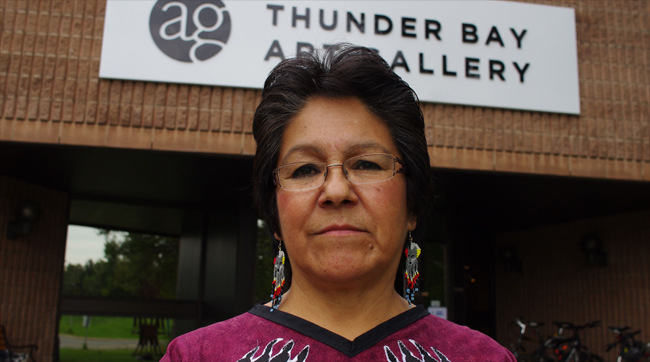Exhibition includes vamps for children who haven’t returned from residential school

By Rick Garrick
THUNDER BAY – Pic River’s Beatrice Twance-Hynes felt the spirits of missing and murdered women after helping install the Walking With Our Sisters exhibition at the Thunder Bay Art Gallery.
“They finished the installation yesterday and I came here after work and it was very touching — I could just feel the spirits of those women,” says Twance-Hynes, a founding member of the Medicine Wheel Spirit Singers. “As I walked around, I could feel it stronger in some places. It’s going to be very emotional in there, with lots of prayers for the families of the missing and murdered Aboriginal women.”
The Walking With Our Sisters exhibition, which features a sacred art bundle of about 1,800 moccasin vamps made by individuals from across Turtle Island and overseas to honour missing and murdered indigenous women and girls, opened with a ceremony on Sept. 19. Created from July 2012 to July 2013, the vamps are on display until Oct. 12.
“It started out with 1,726 and now it is up to 1,780,” Twance-Hynes says. “And there are also vamps in there for the children who haven’t returned from residential school — that is in the middle of the turtle.”
Twance-Hynes encourages people to support the families of the missing or murdered women and girls.
“We have to support the families,” Trance-Hynes says. “We need to help the women to be strong and provide teachings for them to be safe.”
Local Walking With Our Sisters organizer Leanna Sigsworth says the vamps mark the lives of “beautiful women who deserve to be remembered with the utmost respect.”
“This is our opportunity to honour our sisters who have gone missing or have had their lives taken through horrible acts of violence,” Sigsworth says. “This serves as an important reminder of our collective responsibility to recognize that this violence has and continues to take place – and our responsibility to support the families in their grief and healing.”
Walking With Our Sisters founder Christi Belcourt says the exhibition provides a space “to let families and everybody know that their lives were of value.”
“They left large circles of loss when they were taken, when they were murdered or if they are still missing,” Belcourt says. “Their families are in that area of limbo not knowing where their loved one is and they grieve every day for them.”
Belcourt says the exhibition has received overwhelming support from community members wherever it has been presented.
“It is a memorial ceremony,” Belcourt says, noting that the traditional knowledge holders of each community come together to create the ceremony for their community. “It is all done in accordance with traditional protocols of the region and the territory that we are on.”
The exhibition has already visited six communities across Canada and is currently scheduled to visit more than 31 locations over the next six years.
“We don’t accept government funding, so it’s everybody coming together and doing what they can,” Belcourt says. “The issue of our missing sisters is so important and everybody wants something to be done about it.”
The RCMP recently released a report that found that more than 1,181 indigenous women and girls have been murdered or gone missing over the past 30 years, which represents 16 per cent of female homicides and 11.3 per cent of missing women. Aboriginal women make up 4.3 per cent of the women’s population in Canada.


